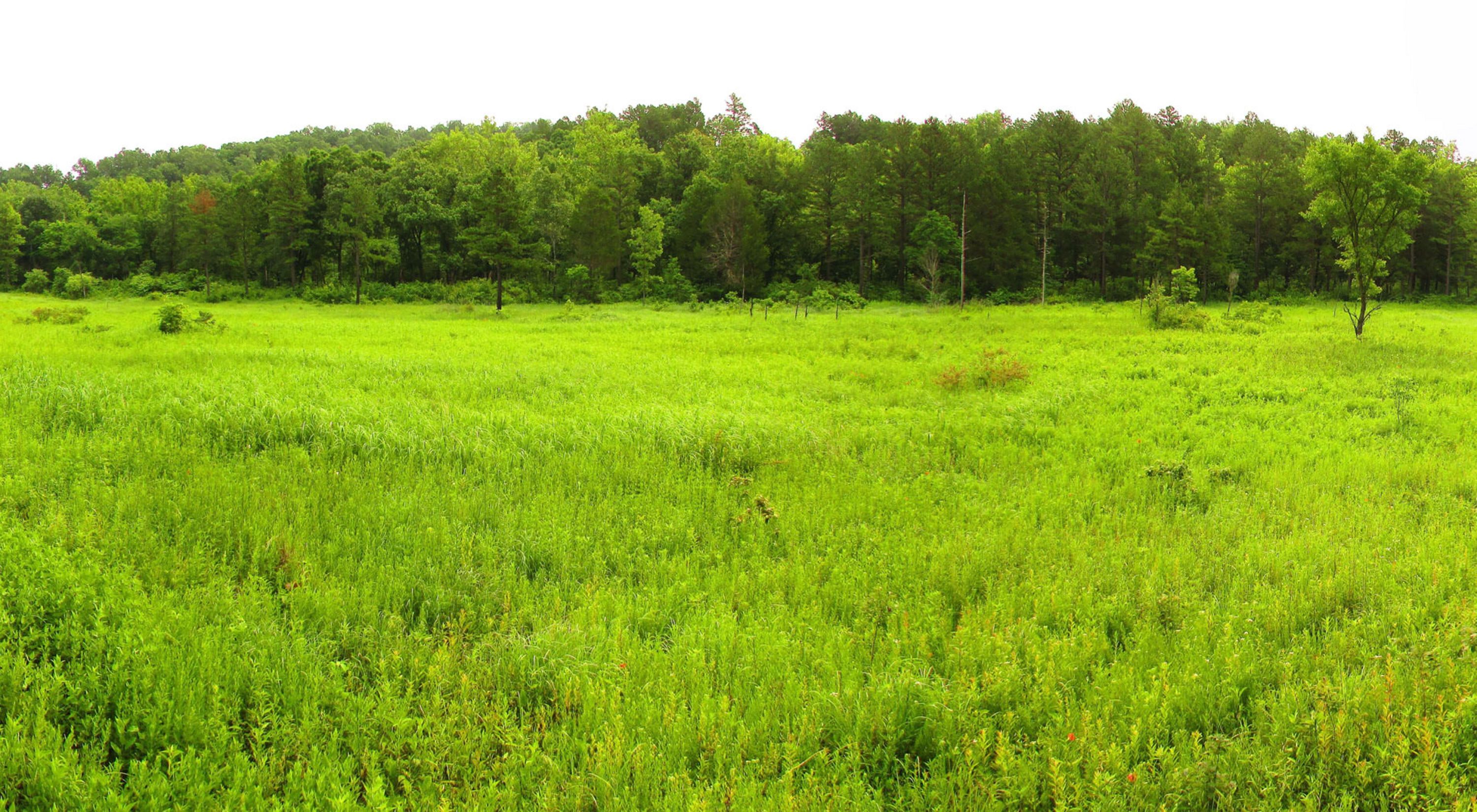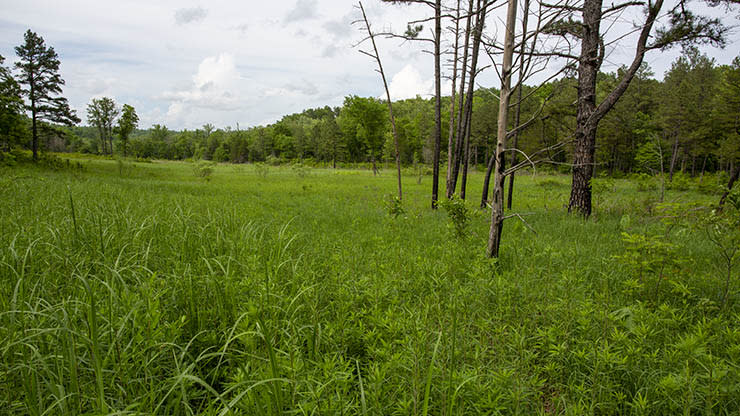
Grasshopper Hollow
Categories
Central (KS, MO)
About
- Protects biologically diverse wetland flora, fauna and/or their habitat
- Supports significant numbers of wetland-dependent fauna, such as water birds or fish
- Rare or unique wetland type within its own biogeographical region. (Meeting this criteria would include, but is not limited to, wetlands with unique hydrology or chemistry that make it rare within its own region)
PROTECTS BIOLOGICALLY DIVERSE WETLAND FLORA, FAUNA AND/OR THEIR HABITAT
Grasshopper Hollow is controlled by the Nature Conservancy whose mission is “to preserve the plants, animals and natural communities that represent the diversity of life on Earth” by protecting the lands and waters they need to survive. Under this mission, Grasshopper Hollow, represents a rare natural community. This rare, natural community contains unique glacial relict species that are not found in other wetland types within Missouri. That is, they are species that were common in Missouri 10,000 years ago when glaciers covered the upper midwest. In the intervening thousands of years Missouri’s climate has gotten warmer and drier. The glacial relict species were able to persist in fens and along spring branches where cool groundwater provides appropriate habitat conditions. Other glacial relict species in Missouri persist on cool, moist north facing bluffs. Within Grasshopper Hollow’s fens, glacial relicts include the four-toed salamander, wood frog, Riddell’s goldenrod, marsh blue violet, interior sedge, tussock sedge, sweet William phlox, and marsh bellflower. Other non-relict, but notable species include beavers, the rare four-toed salamander and the rare wood frog. In 2000, the federally endangered Hine's Emerald Dragonfly was discovered to be breeding at this site. In short, Grasshopper Hollow, a protected Natural Area, safeguards these unique species.
Evidence Attached. See: Grasshopper Hollow Complete Plant List
SUPPORT SIGNIFICANT NUMBERS OF WETLAND-DEPENDENT FAUNA
While no vertebrate species are restricted to karst fens, like Grasshopper Hollow, they do provide important habitat components for several species. Many bird and mammal species will utilize karst fens for drinking water and for foraging on invertebrates found there. Bird species are typically associated with the shrub component of karst fens and include the yellow-breasted chat and common yellowthroat. The western slender glass lizard (Ophisaurus attenuatus attenuatus), four-toed salamander (Hemidactylium scutatum), eastern long-tailed salamander (Eurycea longicauda longicauda) and the dark-sided salamander (Eurycea longicauda melanopleura) all utilize fens.
The federally endangered Hine’s emerald dragonfly (Somatochlora hineana) is a karst fen obligate insect. A key component of fen’s supporting this species is the presence of crayfish burrows created by the devil crayfish (Lacunicambarus diogenes). Other Odonates highly associated with karst fens include the grey petaltail (Tachopteryx thoreyi), seepage dancer (Argia bipunctulata), and the yellow-sided skimmer (Libellula flavida). Other Odonates that utilize karst fens include the springwater dancer (Agria plana) and clamp-tipped emerald (Somatochlora tenebrosa).
The swamp metalmark butterfly (Calephelis muticum) is highly associated with karst fens as it utilizes swamp thistle (Cirsium muticum) as a host plant. Phantom crane flies (Bittacomorpha clavipes) are frequently seen utilizing karst fens. The following snail species often utilize fen habitats: the slender walker (Potamiopsis lapidaria), ice thorn (Carychium exile), white snaggletooth (Gastrocopta tappaniana), blade vertigo (Vertigo milium) and toothless column (Columella simplex).
Beaver can also colonize these locations, creating a larger array of niches for other more aquatic species and typical wetland taxa like fish and waterfowl. In addition to the above, many other native insect species are likely associated with this ecological site, especially native bees, ants, beetles, butterflies and moths, and crickets, grasshoppers and katydids.
RARE OR UNIQUE WETLAND TYPE WITHIN ITS OWN BIOGEOGRAPHICAL REGION
Grasshopper Hollow is the largest unglaciated fen complex in North America. Fens are an important and unique wetland type. Fens are peat-forming wetlands that rely on groundwater input and require thousands of years to develop and cannot easily be restored once destroyed. When we think about the size and scope of Missouri’s wetlands, many of them are riverine, driven by hydrology dominated by overland flow. However, Grasshopper Hollow, a fen, is unique to the area and rare across the United States. Accordingly, this wetland should be considered a Wetland of Distinction.
Evidence Attached. See: Grasshopper Hollow NA Nomination
- Aesthetic/cultural heritage value/provisioning
- Recreation (birdwatching, ecotourism)
- Storm abatement
- Carbon storage
- Water quality improvement
AESTHETIC/CULTURAL HERITAGE VALUE/PROVISIONING
There is a significant cultural connection to these locations in the Ozarks because they were openings within the forest landscape with water. This mirrored locations in the Appalachians in which Scotch-Irish were moving from and therefore locations like Grasshopper Hollow and other fen complexes were places of early European settlement.
RECREATION
Grasshopper Hollow has a self-guided one-half mile long trail with 10 interpretive stations including an observation deck. A spur of the Ozark Trail borders the natural area. Grasshopper Hollow offers opportunities for flora/fauna observation and photography.
STORM ABATEMENT
The discharge of groundwater in karst fens, like Grasshopper Hollow, is very slow and gradual. The velocity is minimal enough that plant roots are able to hold soil and organic matter in place. The build of organic soils over hundreds to thousands of years act as sponge and increases the site’s capacity to hold onto water over time. These attributes contribute to slow discharge of water into the fen and gradual release downstream and contribute to storm abatement for the surrounding catchment. In altered settings elsewhere, ditches concentrate and divert these groundwater flows. The impacts of these actions can be seen after heavy rain events swiftly and dramatically impact adjacent streams with higher and flashier flows. Locations like Grasshopper Hollow contribute to greater stability and persistence of the groundwater table and baseflow of the adjacent headwater stream system.
CARBON STORAGE
Fens represent a large array of ecosystem services, including the highest biodiversity found among wetlands, hydrological services, water purification and carbon sequestration. Fens sequester carbon by accumulating undecomposed plant material, referred to as peat, in the soil. Globally, fens store more than 30% of soil carbon, representing a Carbon stock of 400–550 Gt (gigatons). The fact that Grasshopper Hollow is one of the few places with histic/organic soils in Missouri raises the significance of them being important sites for carbon sequestration. Much of the carbon storage that occurs in Missouri, and particularly in the Ozark Highlands is within the aboveground biomass of the forest. However, the permanently saturated conditions within fens prevent decomposition and lead to the belowground accrual of carbon for hundreds to thousands of years. Although these sites might be small compared to the amount of carbon locked up in the adjacent trees, the longevity of carbon storage within karst fens is a magnitude greater.
WATER QUALITY IMPROVEMENT
Groundwater discharging through the thick organic soil, dense root system of wetland plants, and diverse microbiota of karst fens is like a living water filter benefiting the water quality as it moves through the isolated headwater locations where most karst fens are found. The fact that Grasshopper Hollow is the largest unglaciated fen complex means that this location in particular is benefiting the water moving through it.
This ecosystem is dominate by water, and hydrological change poses some of the most significant threats. Beaver dams have changed the hydrology in some areas of the fens. The Nature Conservancy is managing the activities of beavers where their dams are significantly altering habitats. Fire management is also used not only to reduce the understory, which historically would have been more open with periodic fires, but to maintain the natural elements of the fen.
From the junction of Highway A and Highway 72 in Bunker, travel east on Highway 72 approximately 7.6 miles to Forest Service road 860. Forest Service road 860 is 1.0 mile past the intersection of Highway 72 and Highway TT. Turn left (north) on 860 and travel 0.6 miles to the parking lot and trailhead. Visitors can walk the trail that follows an old road to view the fens.
- Lake
- Pond
- Stream
Primary soil map units within Grasshopper Hollow include:
- Midco very gravelly loam, 1 to 3 percent slopes, occasionally flooded
- Batcave-Farewell complex, 0 to 2 percent slopes, frequently flooded
- Poynor-Clarksville-Scholten complex, 8 to 15 percent slopes, stony
- Coulstone-Bender complex, 15 to 50 percent slopes, very stony
- Clarksville-Scholten complex, 15 to 45 percent slopes, very stony
Fens are wetlands created when calcareous groundwater seeps out to the soil surface and are typically dominated by herbaceous plants kept open by both saturated soils and historically occasional wildfires. The fens in Grasshopper Hollow are created by groundwater moving down through the Gasconade dolomite formation and hitting a resistant layer, likely sandstone, along which the water then runs horizontally and seeps out onto the lower slopes along the valley. Water that feeds these fens originates in the immediate 2,000-acre surface watershed but also from losing streams in the Logan Creek valley to the south, demonstrating the complexity of water movement in karst landscapes.
Fens experienced a decline in acreage at a rate of about eight percent from 1950 to 1970, mostly from mining and draining for cropland, fuel and fertilizer. Because of the large historical loss of this ecosystem type, remaining fens are that much more rare, and it is crucial to protect them. It is important to recognize that while mining and draining these ecosystems provide resources for people, up to 10,000 years are required to form a fen naturally.
Interestingly, fen plant material does not decompose due to growth occurring in saturated, oxygen-free conditions. This undecomposed plant material can provide historical information regarding past plant species composition, and the climate they lived in. In fact, if one were to take a core of a fen, one could reconstruct a time capsule dating back for thousands of years.
Images


